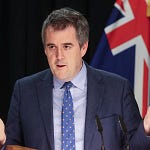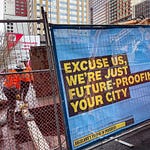(Resent to include correct audio. My apologies.)
TL;DR: Councils and infrastructure managers are warning unplanned and unbuilt-for population growth has created deficits worth hundreds of billions of dollars that councils will have to fund with double-digit rates increases for decades, unless they get extra funding tools or capital help from the Government. LGNZ, Āpōpō.
Meanwhile, the Government announced a review of Kāinga Ora’s finances and will forge ahead this week with repealing Three Waters and RMA legislation, both of which were designed to address the funding needs and planning certainty that councils, infrastructure planners and infrastructure builders are desperate for.
Just as population growth hits 2.5% after 20 years of running at 1.5%-2.0% (when planners expected (and still expect) 0.5% at best), the new National-ACT-NZFirst Government has effectively frozen the infrastructure planning pipeline for months with no clear expectation of what will replace the RMA and Three Waters and when, along with a freeze on planning and funding for Aotearoa-NZ’s largest builder of homes.
In the absence of certainty and funding, councils are resorting to blocking decisions on the underlying infrastructure and zoning for big new greenfields and brownfields housing and other developments. They’re also cancelling new public transport spending and refusing to fund new infrastructure for future population growth in the absence of clear plans to fund public transport and water, both of which are needed to enable any new housing developments. Infrastructure builders are pulling back from investing in their systems and staff to bid for and deliver big public infrastructure, adding to the cost of ramping up any future activity. They point out this lack of a dependable bi-partisan planning and funding pipeline has made our major infrastructure projects the most expensive in the world per kilometre.
Councils are also opting for double-digit rates increases, new water and consenting fees and other charges to ramp up their revenues to cope with the extra costs of population growth they’re not funded for, and to give themselves more borrowing headroom, which is currently limited to 280% of revenues. The six key growth councils, Auckland, Hamilton, Tauranga, Wellington, Christchurch and Queenstown, are all rammed up against their debt limits and being forced to cut services, sell assets and increase rates at double-digit pace.
A Government that has said it is dedicated to firing up infrastructure and housing development to underpin economic growth while also reducing the costs of living, is in effect freezing new development and triggering a whole new range of costs for the businesses and households, along with ramping up pressure on the biggest cost of living, housing, by choking off new housing supply while carrying on with loose migration settings.
Elsewhere in the news this morning:
North Island’s polytechnics are on the verge of financial and staffing collapses as they prepare for the disestablishment of Te Pūkenga, which has prompted the new Tertiary Education Minister to call on them to bring in more international students with temporary work rights to increase revenues — a move going against the PM’s call last week for tighter migration settings; Newshub Lloyd Burr
A fifth wave of covid infections over Christmas/New Year could cause 1,000 deaths and 12,000 hospitalisations, public health expert Michael Baker warned last night; Newshub, 1News
Cyclone Jasper has dumped a year’s worth of rain on Cairns in the last five days, cutting off the city and flooding its airport in a way meterologists said they’d hadn’t seen before and couldn’t have predicted before the sharp rise in global sea and air temperatures this year; and, The Guardian
BP and major tanker shipping group Frontline announced overnight they had suspended sailings through the Red Sea after drone and rocket attacks from Iranian-funded Houthi rebels in Yemen, adding to the withdrawals over the weekend by container shippers Maersk, Hapag-Lloyd and MSC. 30% of trade between Europe and Asia passes through the Suez Canal and past Yemen. US navy officials are building a naval coalition in the Red Sea to “address the Houthi threat” in the coming days. Reuters
Usually at this point in the edition, there’s a paywall that only paying subscribers can see below and hear more detail and analysis in the podcast above. But our subscribers have agreed to open it up for the next few days to show free subscribers what they get. We’d love you to join the community of paying subscribers, who can read and comment on everything inside the paywall all the time and get access to our weekly ‘Hoon’ webinar on the news of the week on Thursdays at 5pm here via YouTubeLive for an hour. The 50%-off offer is open to new subscribers until December 21 (Thursday).
And here’s a special, special deal for under 30s.
Also remember that anyone who is a student or teacher with a .school.nz or .ac.nz email address can sign up for the free version of The Kākā and will be upgraded within 24 hours to the full paid version for free.
Amid record population growth, infrastructure planning and funding is deep-frozen
It’s the perfect recipe for the most expensive infrastructure in the world, the most expensive rental housing in the world and a rash of new double-digit increases in rents, rates, fees and charges that is keeping inflation higher for longer.
In its first 100 days, the new National-ACT-NZ First Government has or will:
freeze planning and funding for the country’s largest house builder (Kāinga Ora);
repeal and dismantle water asset and planning reforms (Three Waters) designed to fund hundreds of billions of water infrastructure building for decades to come, all of which was designed to underwrite the building of hundreds of thousands of new homes in brownfields and greenfields areas of our six largest cities;
repeal, dismantle and replace RMA reforms with an out-of-date earlier version, removing any certainty for planners, builders and funders for years to come and restarting the clock on plans already in the system for years;
freeze and/or cancel public transport, cycling and walking projects in the pipeline for years, all of which were designed to reduce emissions and open up more opportunities for housing densification aimed at improving housing affordability; and,
vaguely suggest an Infrastructure Planning Agency and ‘City Deals’ designed to substitute central Government and council debt funding for private funding at a scale and of a nature never done before, and likely to cost two to three times more than publicly-funded projects over the long run.
It is a lineup of actions that just three weeks ago City Rail Link CEO Sean Sweeney described as the exact opposite of what was needed to improve infrastructure building costs and delivery times.
He described a sector hamstrung by:
a lack of bi-partisan infrastructure planning and funding;
an uncertain pipeline of projects;
a lowest-cost and short-termist approach to procurement; and,
a lack of large-scale builders with long-term skill bases and their own infrastructure.
“This is a crisis. Bipartisan political planning is now urgently required and it has to focus on capability and affordability.”
“What does a healthy construction sector look like? There were three key components to his answer. The first is profitable companies, the second is a skilled workforce and the third is willing clients.” CRL CEO Sean Sweeney talking in a speech to a rail conference in November via NZ Herald-$$$
Speaking to the Herald after his speech, Sweeney cited Fletcher Building’s recent decision to stop tendering for transport projects because public procurement policies were too uncertain and designed to offload risk of cost changes to the builder, including for things such as below-ground risks and legislative changes.
“They say they’re too risky. The prevailing approach has been to load risk on to the contractor, even when it’s unrelated to their work.
“They don’t know the local geology. So either they have to take that risk and it could force them out of business, or they charge a higher price.” Sweeney talking to Simon Wilson via NZ Herald-$$$
Sweeney contrasted the approach with the one taken in Australia.
“They share the risks with the contractors, so the relationships evolve and there are joint expectations of what will happen.
“They have a pipeline of projects, so the better builders know they will get more work. And the worse ones, you can hold their feet to the fire.
“You can get your costs down if the work is not one-off. The long-term proof of concept is the programme to replace level crossings in Melbourne. They started with 25, and now they’re up to a hundred. They have alliances with the contractors, so they gain and then retain experience, and everyone saves money.”
‘At the CRL, in contrast, when the tunnelling was finished, the overseas companies left “and they took 300 highly skilled workers with them”. Sweeney talking to Simon Wilson via NZ Herald-$$$
‘What is needed is not what we’ve got, or are getting’
Sweeney called for a reset to longer-term bipartisan planning and partnerships with an emphasis on sharing risks, rather than short term ‘value for money.’
This week’s decisions reflect a reversion to the exact opposite, where the focus is on reducing Government expenditure on capital and operations in the short term to reduce Budget deficits and borrowing — all with the aim of creating room for tax cuts that boost disposable income able to be leveraged up in residential land, and keeping inflation and mortgage rates low to generate more tax-free gains on leveraged land values.
“If New Zealand is to have any chance of addressing the infrastructure deficit. We will need a complete reset.
“The construction industry has suffered a market failure. Market economics in this industry is a fantasy and the CRL is a living example. We walk into unknowns every three months.” Sweeney talking to Simon Wilson via NZ Herald-$$$
Sweeney referred to the results of a New York University Mellon research project published last month called TransitCosts, which found the CRL was the most expensive rail project in the world to build per kilometer. Data in the report and the chart below the CRL cost US$922 million (NZ$1.5 billion) per kilometer to build, while the average cost per kilometer to build a city rail line in the United States was around US$600 million, the average cost in Australia was around US$300 million and the average cost in Finland, Portugal and Spain was around US$100 million.
The extra cost also wasn’t just due to the project being all-tunnel. Greece’s project recent rail projects were also all-tunnel and cost a sixth of New Zealand’s cost.

The scale of the failure is evident in this chart from Infrastructure Partnerships’ Australia New Zealand Infrastructure Pipeline report showing the relative pipelines of work between Australia’s states.
Kāinga Ora review to look at finances
Housing Minister Chris Bishop and PM Christopher Luxon annnounced former National PM and Finance and Housing Minister Bill English would lead the review of Kāinga Ora’s financial situation, procurement and asset management. Its terms of reference would be released later this week and the review would report back to the Government by the end of March.
Bishop said he was concerned about a rise in the agency’s debt to $12.3 billion in June this year from $2.7 billion in 2018, although its assets had risen from $26.7 billion to $45 billion over that period. That means Kāinga Ora’s asset value rose twice as much as its debt over that time.
“A recent report by the Treasury and Ministry for Housing and Urban Development found that Kāinga Ora’s level of debt had grown from $2.7 billion in 2018 to $12.3 billion in June of this year. Advice released last year suggests that if Kāinga Ora continues on its current trajectory, their debt would reach $28.9 billion by 2033.
“I am deeply concerned about the operating deficit which is already at $520 million in 22/23 and which is forecast to continue increasing. This deficit has a direct impact on OBEGAL and continues to put pressure on the return to OBEGAL surplus.
“Since coming to office Ministers have received further worrying advice about the financial situation of Kāinga Ora. We are not releasing that information at this time as it is commercially sensitive, but it confirms that an independent review is the right course of action.” Bishop statement.
The questions for English are likely to be around whether Kāinga Ora’s build programme of 3,000 homes is extended beyond the current year. National has only committed to this year. It will also no doubt look at how social housing is funded and procured, and whether Kāinga Ora’s costs of close to double per square metre of that of the likes of Simplicity Living are justifiable.
Labour’s approach was to do almost all of it through Kainga Ora, whereas National’s approach under English was to focus capital grants and subsidies on the community housing trust sector.
An infrastructure tragedy ‘coming into view’
Yesterday, Āpōpō and LGNZ called for new funding tools for councils to provide more certainty. An Āpōpō survey of its members found most didn’t think the sector planned well enough.

Āpōpō, the former Institute of Public Works Engineering Australasia New Zealand division, said it supported a call from Local Government NZ for more clarity around funding.
“We need a step change to the way we fund, develop, manage, and maintain our country’s infrastructure; a dramatic increase in potholes is a great representation of what happens when we haven’t invested well enough in our assets.
“Our survey also shows that we need to find new ways to steer ourselves away from an infrastructure tragedy.”Āpōpō President Gary Porteous in a statement
LGNZ President Sam Broughton said councils could not continue to rely on household and business rates to fund infrastructure development. He also called for a shift to a four-year term.
“Councils' share of overall tax revenue has remained at 2% of GDP for the last 50 years, despite our ever-increasing responsibilities.
“Options for new funding mechanisms include revenue sharing between central and local government, which could form part of new city and regional deals.
“Our members have also strongly supported that the Government pay rates on all Crown land, as well as introducing new tools like congestion charging, bed taxes and tourist levies.
“A 4-year term of local government would also make a dramatic improvement in productivity across councils and provide certainty. This would in turn create a longer-term pipeline of work for the private sector to partner with councils and deliver for Aotearoa New Zealand.” LGNZ President Sam Broughton in a statement.
The Kākā Project view
The logjam here is always around property-owning ratepayers and median voters not wanting to pay the higher taxes, rates and congestion and water charges needed to maintain existing infrastructure, manage demand and add to infrastructure to account for higher water quality and emissions reduction standards, along with population growth.
The reforms to taxes and local Government in the late 1980s saw both sides of Parliament agree to limit the size of central and local Government at or below 30% of GDP, assuming that New Zealand’s population was stable.
They then both pursued fast population growth for short-term economic and political ends, without a coherent strategy, public debate or public approval for such strong population growth.
Ultimately, sustaining 1.5% to 2% population growth will need a tax share of GDP greater than 30%, along with water and congestion charges. That will require an open public debate about population growth that obtains a social license for that growth. It will also require an acknowledgement that private debt or equity funding for infrastructure is vastly more expensive than state-funded infrastructure.
The Kākā Project’s suggestion is for:
an agreed long-run population growth forecast for 1.5% to 2.0% per annum to acknowledge the real political and climate refuge pressures on New Zealand over the next 70 years;
a broad-based and low-rate annual tax on residential-zone land values to be used to pay for enough infrastructure, housing and public transport to achieve affordable carbon-zero housing and transport by 2050; and,
a bipartisan agreement of the above that creates an Affordable Housing and Transport Agency to plan, approve, design, procure and run these projects in conjunction with councils and iwi.
Ka kite ano
Bernard












